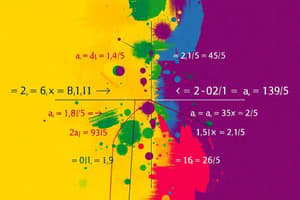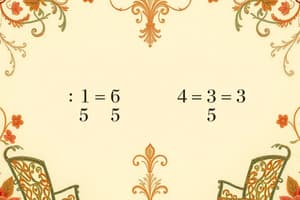Podcast
Questions and Answers
What characterizes independent events in statistics?
What characterizes independent events in statistics?
- The occurrence of one event does not change the probability of another (correct)
- The occurrence of events happens entirely randomly
- The likelihood of an event is conditioned by other events
- The occurrence of one event affects the probability of another
If there are 3 apples among a total of 10 fruits in a basket, what is the probability of selecting an apple in one pick?
If there are 3 apples among a total of 10 fruits in a basket, what is the probability of selecting an apple in one pick?
- $3/7$
- $1/3$
- $7/10$
- $3/10$ (correct)
What does the multiplication rule for independent events state?
What does the multiplication rule for independent events state?
- Independently assess each event without multiplication
- The probability is the average of each event’s likelihood
- Add the probabilities of independent events
- Multiply the probabilities of both events occurring (correct)
Which phrase correctly indicates the application of the multiplication rule for independent events?
Which phrase correctly indicates the application of the multiplication rule for independent events?
What is a simple example of independent events?
What is a simple example of independent events?
In the context of independent events, what does the letter 'P' represent in the probability formula?
In the context of independent events, what does the letter 'P' represent in the probability formula?
How does the probability of getting a fruit from a basket change with the number of fruits available?
How does the probability of getting a fruit from a basket change with the number of fruits available?
If you have an event A with a probability of $P(A) = 0.4$ and an independent event B with $P(B) = 0.5$, what is the combined probability of both occurring?
If you have an event A with a probability of $P(A) = 0.4$ and an independent event B with $P(B) = 0.5$, what is the combined probability of both occurring?
What is the first step in using complementary probability to find the chance of at least one successful event?
What is the first step in using complementary probability to find the chance of at least one successful event?
How can the multiplication rule be applied to determine if two events are independent?
How can the multiplication rule be applied to determine if two events are independent?
If the probability of passing an exam is $\frac{4}{5}$, what is the probability that a student fails?
If the probability of passing an exam is $\frac{4}{5}$, what is the probability that a student fails?
In the example of drawing cards, what determines the probability of drawing at least one queen when the first card is returned to the deck?
In the example of drawing cards, what determines the probability of drawing at least one queen when the first card is returned to the deck?
What is the probability of having at least one person win if three individuals each have a $\frac{1}{10}$ chance of winning a horse race?
What is the probability of having at least one person win if three individuals each have a $\frac{1}{10}$ chance of winning a horse race?
How do repeated trials affect the probability of achieving at least one successful outcome?
How do repeated trials affect the probability of achieving at least one successful outcome?
What can be inferred if the probability of an independent event does not change irrespective of previous outcomes?
What can be inferred if the probability of an independent event does not change irrespective of previous outcomes?
Flashcards
Independent Events
Independent Events
Events that do not influence each other's chances of happening.
Probability
Probability
The likelihood of an event occurring, expressed as a fraction or percentage.
e (Number of favorable outcomes)
e (Number of favorable outcomes)
The number of ways an event can happen.
n (Total number of outcomes)
n (Total number of outcomes)
Signup and view all the flashcards
Multiplication Rule for Independent Events
Multiplication Rule for Independent Events
Signup and view all the flashcards
Probability Formula
Probability Formula
Signup and view all the flashcards
Characteristic of Independent Events
Characteristic of Independent Events
Signup and view all the flashcards
Venn Diagram
Venn Diagram
Signup and view all the flashcards
At Least One Event: Complementary Probability
At Least One Event: Complementary Probability
Signup and view all the flashcards
At Least Once Rule
At Least Once Rule
Signup and view all the flashcards
At Least One Event: Repeated Trials
At Least One Event: Repeated Trials
Signup and view all the flashcards
At Least One Event: Formula (Method A)
At Least One Event: Formula (Method A)
Signup and view all the flashcards
At Least One Event: Formula (Method B)
At Least One Event: Formula (Method B)
Signup and view all the flashcards
Study Notes
Independent Events
- Independent events: The chance of one event occurring does not affect the chance of another event occurring.
- Probability formula: P = e/n (Probability = number of favorable outcomes / total possible outcomes)
- P is the probability of an event.
- e is the number of ways an event can happen.
- n is the total number of possible outcomes.
- Example: The likelihood of a city having a power outage on Saturday is independent of a cow giving birth that same day.
Multiplication Rule for Independent Events
- Multiplication rule: Used to find the probability of multiple independent events occurring. The key word is "and".
- Formula: P(A and B and C...) = P(A) x P(B) x P(C) x ...
- P is the probability of multiple independent events.
- P(A), P(B), P(C)... are the probabilities of the individual events.
- Example: The probability of picking an apple from a basket and a chocolate candy from a jar.
Probability of at Least One Event
-
Finding the probability of at least one successful event.
-
Two methods:
- Method A (Complementary Probability):
-
Find the probability of the event NOT happening.
-
Multiply the probabilities of the event NOT happening.
-
Subtract the result from 1 to get the probability of the event happening at least once.
- Method B (Repeated Trials):
-
Use a formula that accounts for a given number of successes.
-
Example scenarios illustrate how to calculate the probability of at least one event occurring in different scenarios (coin tosses, card draws, exam results, sports betting).
Studying That Suits You
Use AI to generate personalized quizzes and flashcards to suit your learning preferences.




